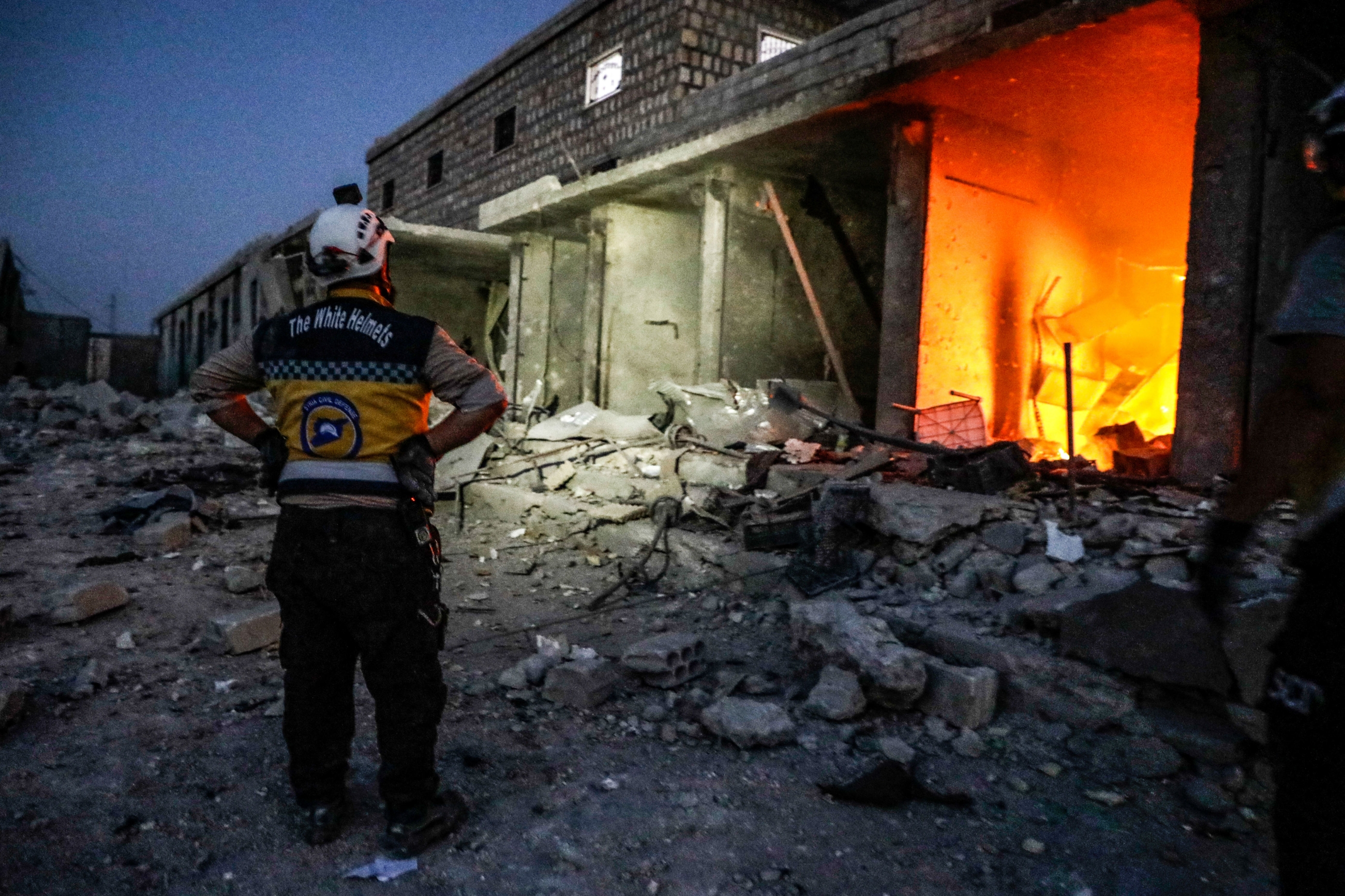'A publicity stunt': Syrians in Idlib baffled by offer of humanitarian corridor exit

As clashes and bombardment raged in Idlib province on Thursday, the Syrian government announced it had opened a “humanitarian corridor” for civilians who want to leave the rebel-held enclave.
Whether such an exit can transport Syrians to safety or not however, is unclear; with many pouring scorn on the proposal as they flee the government's assault and shelter from its arsenal.
Civilians would be allowed to leave Idlib’s southern countryside and the north of neighbouring Hama province through the corridor in the town of Souran, Damascus's statement said.
However, Ahmed al-Sheikho, media director for Syria’s Civil Defence in Idlib, told Middle East Eye that there are effectively no civilians left in Idlib’s southern countryside to use such an exit.
“The majority of people who fled the Khan Sheikhoun and Maaret al-Numan countrysides have chosen to flee north, towards the Turkish border,” Sheikho said.
Souran, located in Hama’s northern countryside, is considered the first line of defence for government forces stationed on the doorstep of the city of Hama.
“The corridor is located in an area already void of civilians. How will the regime receive the people it’s been accusing of supporting terrorists?” activist Massoud Sayyah told MEE.
A doomsday situation
More than 80,000 people were displaced from the Maaret al-Numan eastern countryside since Monday due to the government and Russia’s “hysterical escalation”, a UK-based activist group said.
Abbas Jomaa, a civilian preparing to flee the Maaret al-Numan area, likened the current situation to “doomsday”.
“I have not yet heard of the opening of a corridor. All we hear is the sound of bombings and warplanes,” Jomaa told MEE.
Like Jomaa, several displaced people whom MEE spoke to were surprised to hear that a corridor had been opened up for them when the road to the exit has been cut off by pro-government forces in the first place.
'Even if there were people who would have wanted to use the corridor, they can’t because the road is blocked'
- Abbas Jomaa, civilian
“How can I leave to the side of those who destroyed my village? Even if there were people who would have wanted to use the corridor, they can’t because the road is blocked,” said Jomaa.
Most of Idlib province and parts of neighbouring Hama, Latakia and Aleppo are under the control of Hay’at Tahrir al-Sham, a militant alliance led by Syria’s former al-Qaeda affiliate.
Pro-government forces have escalated their offensive over the past week in the last opposition-held bastion in Syria, and have steadily chipped away at towns and villages in Idlib’s south.
Syrians in opposition-held areas are deeply sceptical and mistrustful of government corridors. Many doubt their security once in Bashar al-Assad-held territory. Others worry they will become moving targets as they make their way out of rebel areas.
One civilian recalled how he chose to flee to Idlib when the government opened a humanitarian crossing in his native Eastern Ghouta during a punishing offensive last year.
“And I would still choose to stay in Idlib today rather than go to a regime area,” he said, wishing to remain anonymous.
The local councils of Kfar Zeita and Latamneh in northern Hama said in similar statements on Thursday that the offensive has emptied their towns of residents.
'Government corridors are a farce and a publicity stunt. I never have and never will cross to regime areas'
- Abdel-Rahman Qaytaz, civilian
“Government corridors are a farce and a publicity stunt. I never have and never will cross to regime areas,” said a displaced civilian, who wished to be named Abdel-Rahman Qaytaz for security reasons.
Hassan al-Shawa, vice president of Idlib’s civilian council, echoed Qaytaz and said he believed that the corridors are “a message from the regime to prepare the world for a new wave of displacement, killings and destruction”.
On Thursday, the government bombing campaign pounded towns east of the key rebel-held town of Maaret al-Numan, including Jarjanaz, Deir al-Sharqi and Tallmannis; where a man and a child were killed and 10 people were wounded, the UK-based Syrian Observatory for Human Rights activist group said.
The goal of the bombardment is to force civilians to flee ahead of a push against Maaret al-Numan, the group said.
Turkish backup
Opposition fighters on Tuesday pulled back from Khan Sheikhoun - one of the province’s largest towns - a strategic win for Assad's government that places pressure on Turkey, which has forces stationed in the nearby town of Morek.
Morek has been cut off from its supply line after government forces attacked and paralysed the highly strategic M5 Damascus-Aleppo highway, down which a Turkish military convoy was heading to the town.
Turkish state media reported on Thursday that Ankara had sent further reinforcements inside northern Syria.
A military convoy was heading from Khirbat al-Jawz crossing towards a Turkish observation point in the town of Jisr al-Shughour in Idlib, Turkey's official Anadolu Agency reported.
Earlier, two Turkish officials told the Reuters news agency that Syrian government forces opened fire on one of Ankara's observation posts on Thursday, without specifying which of Turkey's 12 posts in northwest Syria - set up under an agreement with Russia and Iran - was hit.
Middle East Eye delivers independent and unrivalled coverage and analysis of the Middle East, North Africa and beyond. To learn more about republishing this content and the associated fees, please fill out this form. More about MEE can be found here.





